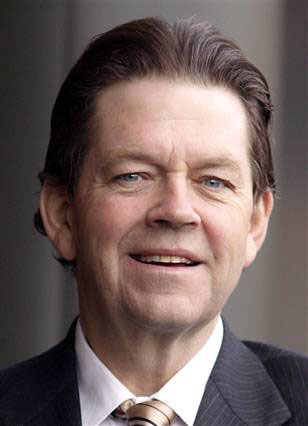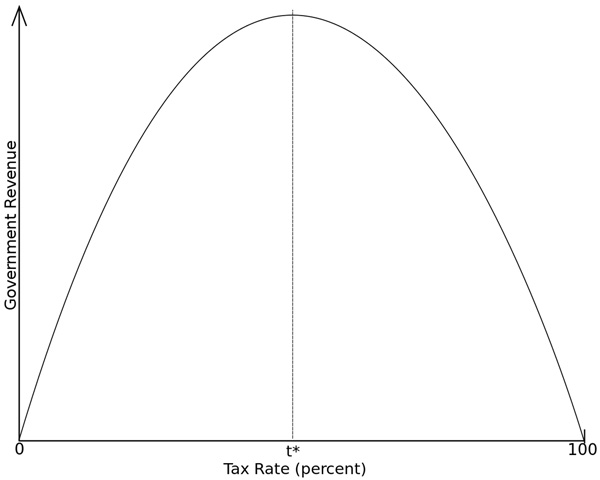Economist: We're Taxing the Wrong Things
Arthur Laffer is sticking to his guns about the hazards of over-taxing the economy.

Arthur Laffer is best known as the economist who invented the Laffer Curve, a diagram that purports to show how an optimal tax rate can maximize revenues without discouraging people from working. In an unexpected role, he recently co-authored a picture book for children called Let’s Chat About Economics! I interviewed Laffer and his co-author, Michelle Balconi, about the book for my Money-Smart Kids column.

Arthur Laffer
BODNAR: With regard to the children’s book, you said that the most important lesson you would like to teach kids is that trade-offs are the essence of economics: You can’t always have all the a you want and all the b you want. What’s the most important lesson you’d like adults to learn about economics?

Sign up for Kiplinger’s Free E-Newsletters
Profit and prosper with the best of expert advice on investing, taxes, retirement, personal finance and more - straight to your e-mail.
Profit and prosper with the best of expert advice - straight to your e-mail.
LAFFER: One lesson I’ve spent my life on is that when you tax something, you get less of it, and when you subsidize something, you get more of it. You know, we tax speeders to get them to stop speeding, and we tax cigarette smokers because we want them to stop smoking. And then we come along and tax people who work, and especially people who work very productively and make a lot of money. Do we do that to stop them from working and stop them from being productive? If you tax work, output and employment, and you subsidize non-work, leisure and unemployment, don’t be surprised if you get less work and a lot more leisure and unemployment. You can’t tax an economy into wealth.
What would you like policymakers to learn about economics? Same thing, or something different? Basically, policymakers should know where the limits of policy are, where government activities cease being better than private, and, vice versa, where private activities cease being better than government. Then you draw the lines and get the hell out of the way. You don’t want a private military, that’s for sure, and you don’t want public grocery stores. The law of diminishing returns is a perfect concept in this context.
So you think the Laffer Curve is still operational? It’s a basic principle of economics that’s always there. Sometimes we’re in a reasonable range of the Laffer Curve, and sometimes we’re not. In terms of what presidents Bush and Obama have done, we’ve gone outside the range and we’ve done a lot of damage to the economy because of government intervention. I think what presidents Reagan and Clinton did were exactly the right policies to create prosperity.
What do you think of the Fed’s zero-interest-rate policy? Forgive me, but I think it’s totally wrong. I mean, who wants to lend mortgage money at 3% to 3.5% for 30 years? The problem is that government people don’t understand that there’s both a supply curve and a demand curve. You can have interest rates that are too high and discourage borrowers, and interest rates that are too low and discourage lenders. There’s an interest rate right in the middle—the Goldilocks interest rate, if you will—where you get just the right amount of borrowers and lenders.
And we’re not there? The government is trying to set rates, which is the wrong thing to do, as opposed to letting the market set rates. That’s why we’ve had such a weak economic recovery. And they just keep on doing the same old policies. It’s really very sad, especially when you see kids in the inner city, teenagers who can’t get a job. After being unemployed for a while they become unemployable, and you’ve created a whole lost generation. We’re bearing the cost.
What made you decide to collaborate on a children’s book? For one thing, Michelle is the most energetic, enthusiastic, focused person you’ve ever seen. How could I say no? Also, I’ve been a professor all my life and a math person. What I try to do is take the math and bring it to life with things like the Laffer Curve or an example I use with Farmer A and Farmer B. In a world with only two people, Farmer A and Farmer B, if Farmer B gets unemployment benefits, who pays for them? Government doesn’t create resources, it redistributes resources. These aren’t the same examples you’d use with kids at the dinner table, but the idea is the same: Trade-offs are the key to economics.

Get Kiplinger Today newsletter — free
Profit and prosper with the best of Kiplinger's advice on investing, taxes, retirement, personal finance and much more. Delivered daily. Enter your email in the box and click Sign Me Up.

Janet Bodnar is editor-at-large of Kiplinger's Personal Finance, a position she assumed after retiring as editor of the magazine after eight years at the helm. She is a nationally recognized expert on the subjects of women and money, children's and family finances, and financial literacy. She is the author of two books, Money Smart Women and Raising Money Smart Kids. As editor-at-large, she writes two popular columns for Kiplinger, "Money Smart Women" and "Living in Retirement." Bodnar is a graduate of St. Bonaventure University and is a member of its Board of Trustees. She received her master's degree from Columbia University, where she was also a Knight-Bagehot Fellow in Business and Economics Journalism.
-
 Stock Market Today: Stocks Soar on China Trade Talk Hopes
Stock Market Today: Stocks Soar on China Trade Talk HopesTreasury Secretary Bessent said current U.S.-China trade relations are unsustainable and signaled hopes for negotiations.
By Karee Venema
-
 2026 Disney Dining Plan Returns: Free Dining for Kids & Resort Benefits
2026 Disney Dining Plan Returns: Free Dining for Kids & Resort BenefitsPlan your 2026 Walt Disney World vacation now. Learn about the returning Disney Dining Plan, how kids aged three to nine eat free, and the exclusive benefits of staying at a Disney Resort hotel.
By Carla Ayers
-
 The Economic Impact of the US-China Trade War
The Economic Impact of the US-China Trade WarThe Letter The US-China trade war will impact US consumers and business. The decoupling process could be messy.
By David Payne
-
 AI Heads to Washington
AI Heads to WashingtonThe Kiplinger Letter There’s big opportunity for AI tools that analyze MRIs and other medical images. But also big challenges that clinicians and companies will have to overcome.
By John Miley
-
 The AI Doctor Coming to Read Your Test Results
The AI Doctor Coming to Read Your Test ResultsThe Kiplinger Letter There’s big opportunity for AI tools that analyze CAT scans, MRIs and other medical images. But there are also big challenges that human clinicians and tech companies will have to overcome.
By John Miley
-
 The New Space Age Takes Off
The New Space Age Takes OffThe Kiplinger Letter From fast broadband to SOS texting, space has never been more embedded in peoples’ lives. The future is even more exciting for rockets, satellites and emerging space tech.
By John Miley
-
 Rising AI Demand Stokes Undersea Investments
Rising AI Demand Stokes Undersea InvestmentsThe Kiplinger Letter As demand soars for AI, there’s a need to transport huge amounts of data across oceans. Tech giants have big plans for new submarine cables, including the longest ever.
By John Miley
-
 What DOGE is Doing Now
What DOGE is Doing NowThe Kiplinger Letter As Musk's DOGE pursues its ambitious agenda, uncertainty and legal challenges are mounting — causing frustration for Trump.
By Matthew Housiaux
-
 A Move Away From Free Trade
A Move Away From Free TradeThe Letter President Trump says long-term gain will be worth short-term pain, but the pain could be significant this year.
By David Payne
-
 Trump’s Whirlwind Month of Crypto Moves
Trump’s Whirlwind Month of Crypto MovesThe Kiplinger Letter The Trump administration wants to strengthen U.S. leadership in the cryptocurrency industry by providing regulatory clarity.
By Rodrigo Sermeño